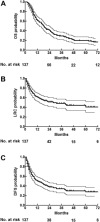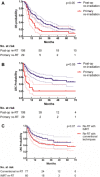Reirradiation of head and neck cancer: Long-term disease control and toxicity
- PMID: 28263446
- PMCID: PMC5485062
- DOI: 10.1002/hed.24733
Reirradiation of head and neck cancer: Long-term disease control and toxicity
Abstract
Background: The purpose of this study was to report long-term disease control and late radiation toxicity for patients reirradiated for head and neck cancer.
Methods: We conducted a retrospective analysis of 137 patients reirradiated with a prescribed dose ≥45 Gy between 1986 and 2013 for a recurrent or second primary malignancy. Endpoints were locoregional control, overall survival (OS), and grade ≥4 late complications according to European Organization for Research and Treatment of Cancer (EORTC)/Radiation Therapy Oncology Group (RTOG) criteria.
Results: Five-year locoregional control rates were 46% for patients reirradiated postoperatively versus 20% for patients who underwent reirradiation as the primary treatment (p < .05). Sixteen cases of serious (grade ≥4) late toxicity were seen in 11 patients (actuarial 28% at 5 years). In patients reirradiated with intensity-modulated radiotherapy (IMRT), a borderline improved locoregional control was observed (49% vs 36%; p = .07), whereas late complication rates did not differ.
Conclusion: Reirradiation should be considered for patients with a recurrent or second primary head and neck cancer, especially postoperatively, if indicated. © 2017 Wiley Periodicals, Inc. Head Neck 39: 1122-1130, 2017.
Keywords: disease control; head and neck cancer; intensity-modulated radiotherapy (IMRT); late toxicity; reirradiation.
© 2017 The Authors Head & Neck Published by Wiley Periodicals, Inc.
Figures




References
-
- Blanchard P, Baujat B, Holostenco V, et al. Meta‐analysis of chemotherapy in head and neck cancer (MACH‐NC): a comprehensive analysis by tumour site. Radiother Oncol 2011;100:33–40. - PubMed
-
- Brockstein B, Haraf DJ, Rademaker AW, et al. Patterns of failure, prognostic factors and survival in locoregionally advanced head and neck cancer treated with concomitant chemoradiotherapy: a 9‐year, 337‐patient, multi‐institutional experience. Ann Oncol 2004;15:1179–1186. - PubMed
-
- Schwartz LH, Ozsahin M, Zhang GN, et al. Synchronous and metachronous head and neck carcinomas. Cancer 1994;74:1933–1938. - PubMed
-
- Goodwin WJ Jr. Salvage surgery for patients with recurrent squamous cell carcinoma of the upper aerodigestive tract: when do the ends justify the means? Laryngoscope 2000;110(3 Pt 2 Suppl 93):1–18. - PubMed
-
- McDonald MW, Lawson J, Garg MK, et al. ACR appropriateness criteria retreatment of recurrent head and neck cancer after prior definitive radiation expert panel on radiation oncology‐head and neck cancer. Int J Radiat Oncol Biol Phys 2011;80:1292–1298. - PubMed
MeSH terms
LinkOut - more resources
Full Text Sources
Other Literature Sources
Medical

